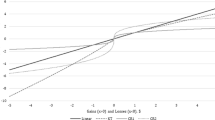Abstract
This paper presents a method for axiomatizing a variety of models for decision making under uncertainty, including Expected Utility and Cumulative Prospect Theory. This method identifies, for each model, the situations that permit consistent inferences about the ordering of value differences. Examples of rankdependent and sign-dependent preference patterns are used to motivate the models and the “tradeoff consistency” axioms that characterize them. The major properties of the value function in Cumulative Prospect Theory—diminishing sensitivity and loss aversion—are contrasted with the principle of diminishing marginal utility that is commonly assumed in Expected Utility.
Similar content being viewed by others
References
Chateauneuf, A. (1990). “On the Use of Comonotonicity in the Axiomatization of EURDP Theory for Arbitrary Consequences.” Extended abstract presented at Fifth International Conference on the Foundations and Applications of Utility, Risk and Decision Theory (FUR-90), CERMSEM, University of Paris I.
Chateauneuf, A. and M. Cohen. (1990). “Risk Seeking with Diminishing Marginal Utility in a Non-Expected Utility Model,” CERMSEM, University of Paris I.
Chateauneuf, A. and P.P. Wakker. (1991). “From Local to Global Additive Representation,”Journal of Mathematical Economics, forthcoming.
Chew, S.H. (1989). “The Rank-Dependent Quasilinear Mean.” Unpublished manuscript, Department of Economics, University of California, Irvine.
Chew, S.H., and L.G. Epstein. (1989). “Axiomatic Rank-Dependent Means,”Annals of Operations Research 19, 299–309.
Chew, S.H., E. Kami, and Z. Safra. (1987). “Risk Aversion in the Theory of Expected Utility with Rank Dependent Probabilities,”Journal of Economic Theory 42, 370–381.
Chew, S.H. and P.P. Wakker. (1991). “Generalizing Choquet Expected Utility by Weakening Savage's Sure-Thing Principle,” Irvine Research Unit in Mathematical Behavioral Sciences, MBS 91-16, University of California, Irvine.
Choquet, G. (1953-4). “Theory of Capacities,”Annales de l'Institut Fourier (Grenoble), 5, 131–295.
Fishburn, P.C. (1988).Nonlinear Preference and Utility Theory. Baltimore: Johns Hopkins University Press.
Gilboa, I. (1987). “Expected Utility with Purely Subjective Non-Additive Probabilities,”Journal of Mathematical Economics 16, 65–88.
Green, J. and B. Jullien. (1988). “Ordinal Independence in Non-Linear Utility Theory,”Journal of Risk and Uncertainty 1, 355–387. (Erratum 2, 1989, 119).
Kahneman, D. and A. Tversky. (1979). “Prospect Theory: An Analysis of Decision under Risk,”Econometrica 47, 263–291.
Krantz, D.H., R.D. Luce, P. Suppes, and A. Tversky, (1971).Foundations of Measurement, vol. 1.(Additive and Polynomial Representations). New York: Academic Press.
Kelley, J.L. (1955).General Topology. London: Van Nostrand.
Luce, R.D., and P.C. Fishburn. (1991). “RankandSign Dependent Linear Utility Models for Finite FirstOrder Gambles,”Journal of Risk and Undertainty 4, 29–59.
Machina, M.J. (1982). “‘Expected Utility’ Analysis without the Independence Axiom,”Econometrica 50, 277–323.
Markowitz, H. (1952). “The Utility of Wealth,”Journal of Political Economy, 60, 151–158.
Miyamoto, J.M. (1988). “Generic Utility Theory: Measurement Foundations and Applications in Multiattribute Utility Theory,”Journal of Mathematical Psychology 32, 357–404.
Quiggin, J. (1982). “A Theory of Anticipated Utility,”Journal of Economic Behavior and Organization 3, 323–343.
Schmeidler, D. (1989). “Subjective Probability and Expected Utility without Additivity,”Econometrica 57, 571–587.
Segal, U. (1993). “The Measure Representation: A Correction,”Journal of Risk and Uncertainty 6, 99–107.
Starmer, C., and R. Sugden. (1989). “Violations of the Independence Axiom in Common Ratio Problems: An Experimental Test of Some Competing Hypotheses,”Annals of Operations Research 19, 79–101.
Tversky, A., and D. Kahneman. (1992). “Advances in Prospect Theory: Cumulative Representation of Uncertainty,”Journal of Risk and Uncertainty 5, 297–323.
Tversky, A., S. Sattath, and P. Slovic. (1988). “Contingent Weighting in Judgment and Choice,”Psychological Review 95, 371–384.
Wakker, P.P. (1989).Additive Representations of Preferences: A New Foundation of Decision Analysis. Dordrecht: Kluwer Academic Publishers.
Wakker, P.P. (1990a). “Under Stochastic Dominance Choquet-Expected Utility and Anticipated Utility are Identical,”Theory and Decision 29, 119–132.
Wakker, P.P. (1990b). “Separating Marginal Utility and Probabilistic Risk Aversion.” Theory and Decision, forthcoming.
Wakker, P.P. (1991). “Additive Representations on Rank-Ordered Sets. I. The Algebraic Approach,”Journal of Mathematical Psychology 35, 501–531.
Wakker, P.P. (1993a). “Additive Representations on Rank-Ordered Sets. II. The Topological Approach,”Journal of Mathematical Economics, 22, 1–26.
Wakker, P.P. (1993b). “Unbounded Utility for Savage's ‘Foundations of Statistics’, and other Models,”Mathematics of Operations Research, 18, 446–485.
Wakker, P.P. (1993c). “Counterexamples to Segal's Measure Representation Theorem,”Journal of Risk and Uncertainty 6, 91–98.
Weymark, J.A. (1981). “Generalized Gini Inequality Indices,”Mathematical Social Sciences 1, 409–430.
Yaari, M.E. (1987). “The Dual Theory of Choice under Risk,”Econometrica 55, 95–115.
Author information
Authors and Affiliations
Additional information
The research of the first author has been made possible by a fellowship of the Royal Netherlands Academy of Arts and Sciences. This work was supported by Grant No. 89-0064 from the Air Force Office of Scientific Research to the second author.
Rights and permissions
About this article
Cite this article
Wakker, P., Tversky, A. An axiomatization of cumulative prospect theory. J Risk Uncertainty 7, 147–175 (1993). https://doi.org/10.1007/BF01065812
Issue Date:
DOI: https://doi.org/10.1007/BF01065812




